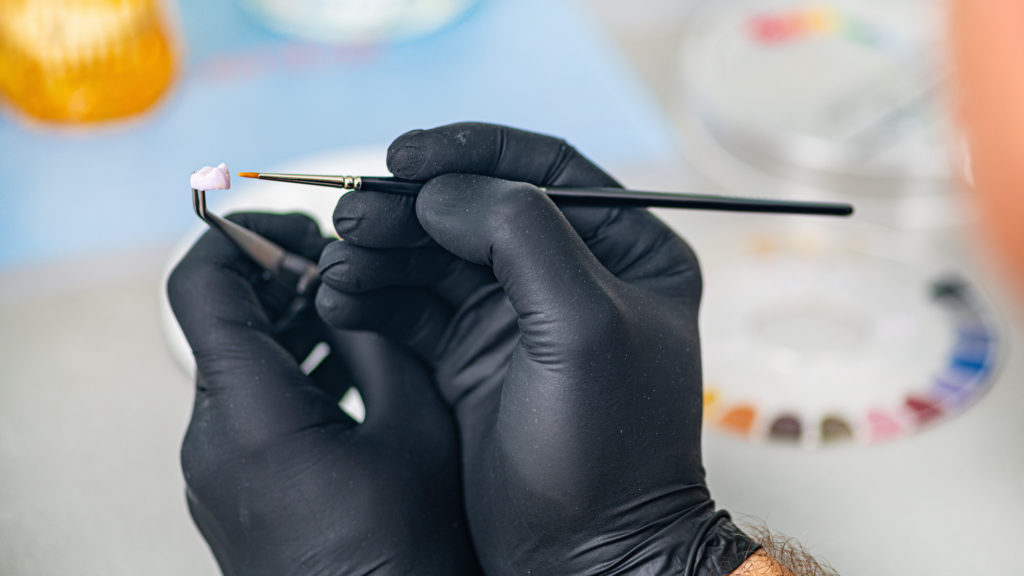The art of reconstruction lies in ability to achieve harmony in chewing system:
- Consistent & repeatable bite,
- Withstand destructive force parafunction,
- Harmony with muscles and joint function,
- Architecture-geometry-physiology
- Beautiful art of occlusion.
Reconstruction:
- Treats teeth, not the causes damage
- Unstable joint destroys accuracy
- Destructive parafunction destroys
Repeatable bite:
- When jaw joint is unstable, the bite cannot be perfected
- Occlusal stability lies in getting the same bite repeatedly
- Joint instablity means “moderate to severe jaw joint damage”
- Jaw joint stability established before reconstruction
- If jaw joint is stable, reconstruction can begin
- Jaw joint unstable, location mountains (cusps) & valleys (fossas) is in question
Stability is difficult to determine:
- Joint Instability
- Disc displacement
- Osteoarthritis
- Muscle stability
- High anxiety-Emotional Hyjacking
- Unmedicated or undiagnosed bipolar
- Mechanical Instability
- Hypermobility
- Mod Dual bite
- Parafunctional Instability
- Destructive grinder
- Change bite every night
Names for art of managing occlusion?
- Prosthodontics
- Equilibration
- Reconstruction
- Prosthodontics
- Equilibration
- Reconstruction
Why are some reconstructions not successful?
- Correct bite
- Hypermobility
- Muscle stability
- Trauma’s
- Harmony system
- Mechanically stable
- Joint instability
- Emotional instability
- Destructive parafunction
- Healing ability
- Based on science
- Geometry/Physiology/Architecture
Emotional Instability:
- Anxiety is maintained at high levels or severe spikes of anxiety
- High anxiety creates muscle recruitment disallowing the chewing system to have coordinated function.
- Function of chewing system is dependent co-ordinated muscle contraction
- Anxiety disrupts this harmony allowing tearing ligaments
- Anxiety makes it difficult achieve correct or repeatable bite.
- High anxiety creates environments of distrust,
- We want doctor to be accurate, but our muscles defy that need
- Emotional instability makes it difficult to complete task-goals-treatment plans
Emotional stability (these are descriptors not lables)
- High anxiety-worry-fret-perfectionist
- Spikes of fear
- Moderate anxiety continuously
- Unmedicated or undiagnosed bipolar
- PTSD’s, Emotional Hyjacking, Panic attack
Destructive grinder:
- Only 2 catagories grinders:
- Grinder
- Not a grinder
- Levels grinding:
- Mild
- Moderate
- Destructive
- Grinding is movement disorder not bad habit
- Destroys:
- Teeth
- Joint
- Muscle
- Bone support
- Hidden & Destructive in 5-15% population
- Reconstruction treats 1 symptom = tooth damage
- Destruction parafunction destroys art
- Repeat reconstruction later on-- playing hump-de-dump-de -- until all is lost
- Waste valuable resources (teeth, money, time)
- Pre op chewing system orthopedics reduces destructive forces
- Post op orthotic protects beautiful art
Protect your Investment: When you reconstruct a case with your precision products, should you not protect these investments from destructive forces that can even destroy God’s materials.
Mechanical Instability
- Success reconstruction:
- Jaw joint stability
- Destructive parafunction managed
- Names for bite instability
- Dual bites
- Multiple bites
- CR=/=CO
- Jaw joint bite =/= tooth bite
- Why mechanical instability
- Multiple reconstructions
- Hypermobile joint
- Multiple equilibrations
- High Anxiety-Emotional Hyjacking
- Loose & floppy disc
- Reposition joint by ARS-LVI-Olmos
- Occlusal neurotic-OCD
- Violation airway
Hypermobile joint
- Open locks is name we give Jaw joint when hypermobile
- Erlos Danlos is hypermobility in many joints body
- Breighton score can be use to screen for TMD hypermobility
- How do you get precise jaw joint bite w/ loose floppy TMD ?
- Repeat Open lock-tears lateral ligament-displaces disc = increase
Jaw joint instability:
- Sudden Displace disc,
- Osteoarthritis,
- Rheumatoid arthritis
Expanding our knowledge from pioneers: Pankey, Dawson, Mahan, Gremillion,
- Joint Stability
- Destructive Parafunction
- Science before sales
- Emotional-spiritual-physical maturity
Love pioneers determination for accuracy, insight, courage, foresight (Pankey, Dawson, Mahan, Tanner, Spears, anyone Not listed)
Imperfections in chewing system should be managed or treated before reconstruction to achieve the greatest accuracy
OCCLUSION or BITE STABILITY
Occlusion:
- how cusps and fossa fit & work together
- how mountains & valleys are positioned
0ne who studies accuracy of occlusion or bites
- Occlusionist
- Prosthodontist
- Graduate Pankey-Dawson-Spears
Guidelines for Occlusionist-Prosthodontis:
- Refer Orofacial Pain Specialist for
- Destructive parafunction
- Jaw joint Instability
- Emotional Stability
- Study complexity occlusion
- Understand geometry of mouth
- Perfectionist
- Diagnose jaw joint stability
- Understand necessity accuracy of bite
- Diagnose destructive parafunction
- Diagnose emotional instability
Important Questions for Prosthodontist-Occlusionist:
- Can you “Fix” all cases ?
- Why your great skills could not overcome all obstacles?
- What are obstacles to success?
- Which cases do I need to recruit orofacial pain specialist?
- When expand team: perio, ortho, oral surgery, endo, medical?
- Why occlusal therapies removed some symptoms but not others ?
Guidelines for Prosthodontist:
- Do I run my practice based on my ego or science- do I believe my own press- do I stand on my crediatials ?
- Can I fix a bad bite with jaw joint in stability
- Can I fix a bad bite in presence of destructive parafunction
- Can I fix a bad bite with emotional instability

 Raleigh Facial Pain © 2025 All Rights Reserved.
Raleigh Facial Pain © 2025 All Rights Reserved.